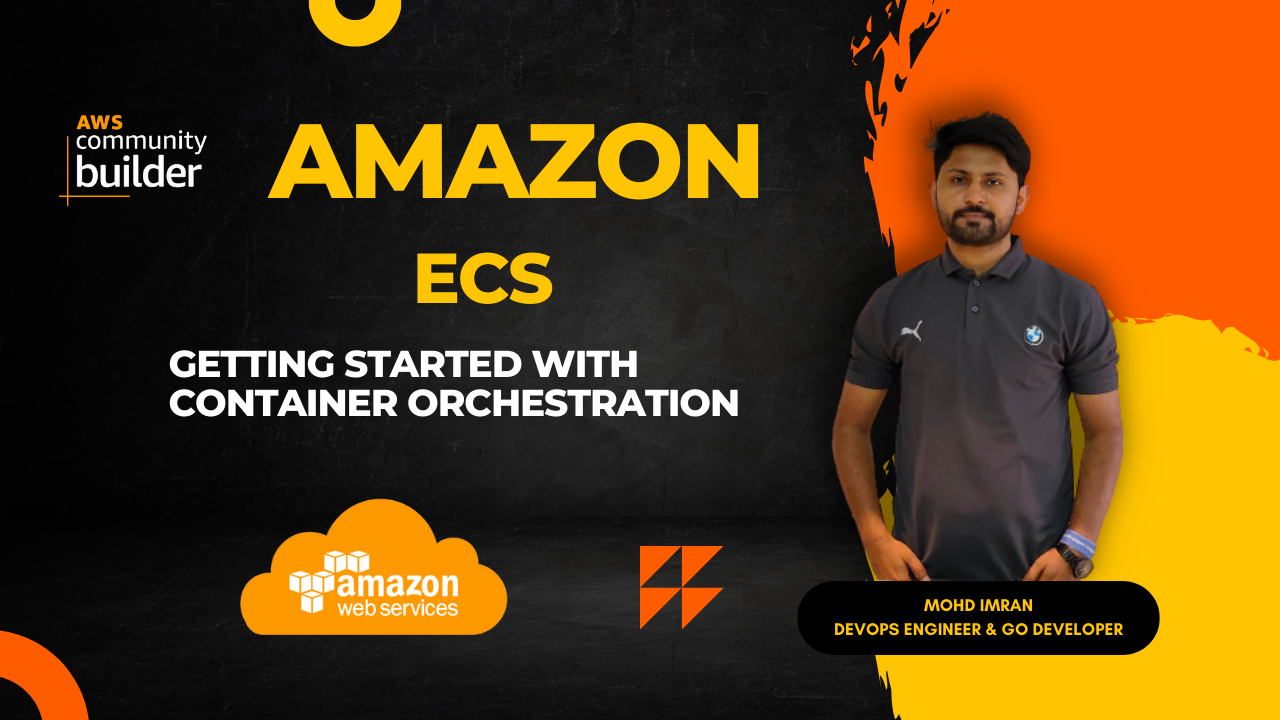A Beginners Guide to Amazon ECS: Getting Started with Container Orchestration
 Mohammad Imran
Mohammad Imran
Title: Unveiling the Power of Amazon ECS: A Guide to Container Orchestration
In the dynamic landscape of cloud computing and containerization, Amazon Web Services (AWS) has been a frontrunner, offering a plethora of services to cater to diverse needs. Among these, Amazon Elastic Container Service (Amazon ECS) stands out as a robust and efficient solution for managing containers at scale. Whether you're a startup, an enterprise, or somewhere in between, understanding and harnessing the capabilities of Amazon ECS can significantly streamline your containerized application deployment process. In this blog post, we'll delve into the intricacies of Amazon ECS, exploring its features, benefits, and how it can revolutionize your container orchestration strategy.
What is Amazon ECS?
Amazon ECS is a fully-managed container orchestration service provided by AWS. It enables you to run, stop, and manage Docker containers on a cluster. At its core, ECS simplifies the process of deploying, managing, and scaling containerized applications by abstracting away the underlying infrastructure complexities. With ECS, you can focus more on developing your applications and less on managing the infrastructure required to run them.
Key Features and Components
Clusters: Amazon ECS operates within clusters, which are logical groupings of container instances (EC2 instances or AWS Fargate tasks) where you can run your containers. Clusters provide the foundation for managing your containerized environment.
Task Definitions: A task definition is a blueprint for your application, specifying parameters such as which Docker image to use, how much CPU and memory to allocate, networking configuration, and more. Task definitions allow you to define one or more containers that form your application.
Services: ECS services allow you to define long-running tasks or services that ensure a specified number of instances of a task definition are running and automatically handle scaling, load balancing, and container health checks.
Task Placement Strategies: ECS offers flexible task placement strategies to optimize resource utilization and meet specific requirements. You can choose between Binpack, Random, and Spread strategies to distribute tasks across your cluster based on CPU and memory requirements.
Integration with AWS Fargate: With AWS Fargate, you can run containers without managing the underlying infrastructure. ECS seamlessly integrates with Fargate, allowing you to launch tasks without provisioning or managing servers.
Load Balancing: ECS integrates with Elastic Load Balancing (ELB) to distribute incoming traffic across your containers. This ensures high availability and scalability for your applications.
Benefits of Amazon ECS
Scalability: Amazon ECS enables you to scale your containerized applications effortlessly. With features like auto-scaling and service scaling, ECS can automatically adjust the number of running tasks based on demand, ensuring optimal performance and cost efficiency.
High Availability: By leveraging ECS services and integration with ELB, you can achieve high availability for your applications. ECS automatically replaces unhealthy containers and maintains the desired number of running tasks, minimizing downtime and ensuring reliability.
Cost Efficiency: With ECS, you only pay for the resources you use. AWS Fargate further enhances cost efficiency by eliminating the need to provision and manage servers. Additionally, ECS helps optimize resource utilization through efficient task placement strategies.
Operational Simplicity: Managing containerized applications can be complex, but ECS simplifies this process by providing a managed environment. From deployment to monitoring and scaling, ECS automates many tasks, reducing operational overhead and allowing you to focus on innovation.
Integration with AWS Ecosystem: As part of the AWS ecosystem, ECS seamlessly integrates with other AWS services such as CloudWatch for monitoring, AWS Identity and Access Management (IAM) for security, and AWS CloudFormation for infrastructure as code.
Getting Started with Amazon ECS
Getting started with Amazon ECS is straightforward:
Create a Cluster: Start by creating an ECS cluster using the AWS Management Console, AWS CLI, or AWS CloudFormation.
Define Task Definitions: Define task definitions that specify how your containers should run, including Docker image, resource requirements, networking, and more.
Launch Tasks or Services: Launch tasks directly or create ECS services to manage long-running tasks. Configure auto-scaling and load balancing as needed.
Monitor and Manage: Monitor the health and performance of your containers using CloudWatch metrics and logs. Use ECS APIs or the console to manage tasks, services, and clusters.
Conclusion
Amazon ECS offers a powerful and flexible solution for container orchestration on AWS. Whether you're running microservices, batch processing workloads, or any other containerized application, ECS provides the scalability, reliability, and simplicity you need to succeed in today's fast-paced environment. By leveraging ECS, you can streamline your deployment process, optimize resource utilization, and focus on delivering value to your customers. Embrace the power of Amazon ECS and unlock the full potential of containerization in the cloud.
Subscribe to my newsletter
Read articles from Mohammad Imran directly inside your inbox. Subscribe to the newsletter, and don't miss out.
Written by

Mohammad Imran
Mohammad Imran
DevOps 👨💻 | Co-Founder & Community manager @ GrowInCommunity | AWS Community Builder | Open Source Advocate 🥑| Tech Blogger 👨💻| Cloud Computing | Cloud Native